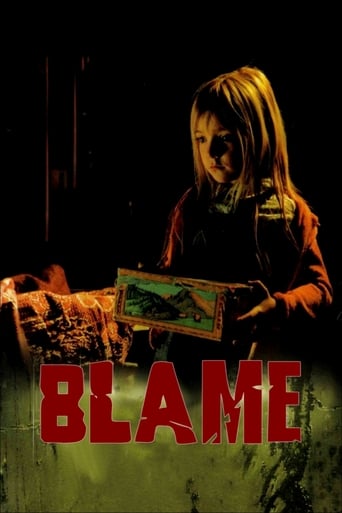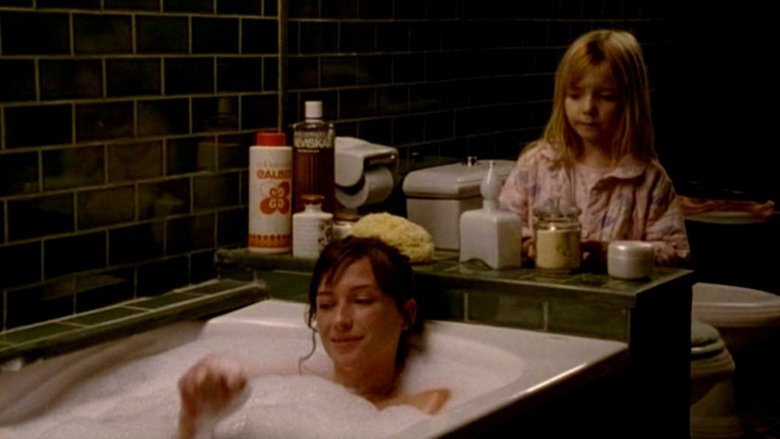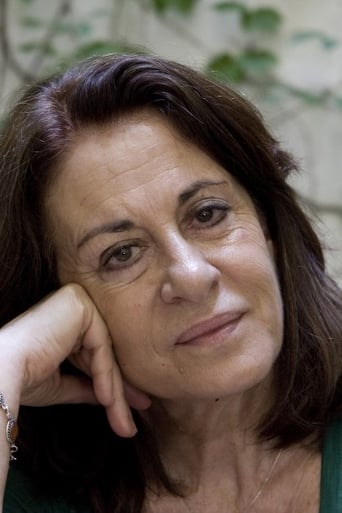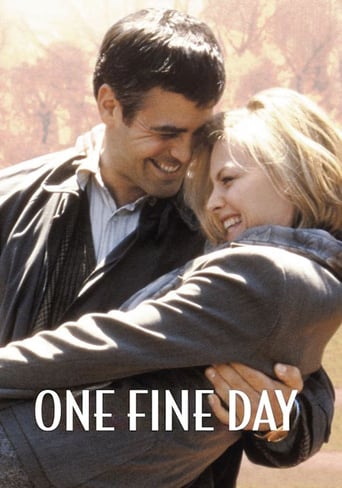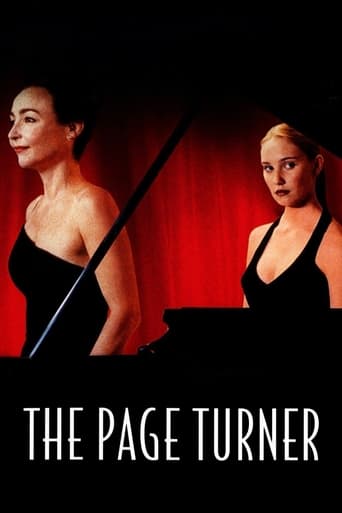Blame (2006)
When nurse Gloria has financial difficulties, her friend Dr. Ana Torres invites her to move with her six year-old daughter Vicky to her old big house where she runs a gynecologic clinic. In return, Gloria will assist Ana in her clinic in the afternoons.
Watch Trailer
Cast


Similar titles
Reviews
Very Cool!!!
To all those who have watched it: I hope you enjoyed it as much as I do.
A film with more than the usual spoiler issues. Talking about it in any detail feels akin to handing you a gift-wrapped present and saying, "I hope you like it -- It's a thriller about a diabolical secret experiment."
The thing I enjoyed most about the film is the fact that it doesn't shy away from being a super-sized-cliche;
Part of a six-part series of Spanish made-for-TV movies entitled SIX FILMS TO KEEP YOU AWAKE, BLAME is a hard-hitting ghost story about an abortionist. It's a film that's light years ahead of current Hollywood competition and has more in line with the creepy, slow-moving perils of modern Asian horror cinema. That's right: despite the disturbing subject matter, this is an old-fashioned film through-and-through in which the scares come from noises in empty rooms and inexplicable occurrences rather than any shocking killer babies a la the IT'S ALIVE films and their B-movie ilk.Blame benefits from a uniformly excellent cast that includes a young child actress whose fragile yet sinister performance recalls Heather O'Rourke of POLTERGEIST fame. The direction is assured and confident, leading to a beautiful looking movie that makes the best out of its rather mundane, otherwise nondescript locations: the run-down house, for instance, in which much of the film takes place, is almost a character in its own right. In the end, this is a film about the difficult topic of abortion and all the complexities that go with it: it's utterly moving, sometimes heartbreaking and very upsetting. By the end, it's become a far more intelligent and mature reflection on the topic than we, as viewer, had any right to expect, and I can't recommend it enough.
The body underneath a sheet, blood seeping through, as it is being pulled away by some mysterious woman with a little girl looking on from her window--quite an indelible image to open this particular episode of the 6 films to keep you awake. Gloria goes to live in the home of Dr. Ana Torres, a daughter along with her, and she appears weary, baggage of the past visible on the face and in demeanor. A nurse Gloria will also assist Torres who keeps a lab in her home to perform abortions.A funny knock on the door to a room which Dr. Torres doesn't acknowledge yet Gloria hears. A phone call Dr. Torres strangely evades much to Gloria's dismay. It's very clear early on that Torres is interested sexually in Gloria, the way she caresses her hand or clutches the arm lovingly(it's insinuated and subtle, but obvious; Gloria seems puzzled and unsure how to respond to Torres' advances). Torres even mentions that she would like to help Gloria "pretty herself up", to bring out her beauty which seems to hide underneath a drab exterior.That phone call I mentioned--Christina, a woman sought after on the phone; her name appears on a necklace along with Ana's for which Gloria's daughter finds. Ana is a liberal, free-thinker who sees(perhaps blindly)Gloria as someone who has moved away from the old-fashioned principles of past society and asks her to help give abortions in the clinic. There's kind of an indication that Ana performs a steady influx of abortions regularly..Dr. Torres even seems to talk one young woman(who doesn't know which the father is between two men)into getting an abortion. Dr. Torres, though, informs her clients that she will perform these abortions when they are the most safe, before three months pregnant due to the danger.Ana represents change in mores, a lesbian who performs abortions without guilt, as if any other procedure and attempts to kiss Gloria. Gloria, on the other hand, is a bit put off by assisting in the aborting of a small fetus and resists an attempt by Ana to kiss her. Torres keeps trying, and Gloria keeps turning away. It's clear that Torres longs for companionship and love.Gloria learns from a busybody religious wallflower who lives next door that three women(obviously lovers)have came and went, Ana having coddled them until they no longer needed her. Then comes Javier which further complicates things. Then pregnancy. Torres is dejected in that her love is constantly spurned and instead Gloria is impregnated by a man who could never give that same kind of affection. But with an economy uncertain and possible lay offs looming at the hospital Gloria often works, the idea of having a second child absent a father seems too risky and troublesome a task to endure. Repercussions of an abortion become the turning point in the friendship of Gloria and Ana which results in tragedy. BLAME delves primarily into the topic of abortion and how it concerns the mental breakdown of one fragile woman who decides to have it done despite truly wanting to keep it. Gloria's daughter contributes to the breakdown by mentioning in various ways how she was disappointed in not getting a new brother. We see how other women make the choice and Dr. Torres gladly performs them without fail while Gloria reluctantly assists, later herself in the same position. This felt curiously anti-abortion, the way the procedure and those who have it(and the doctor performing them)is portrayed as almost a crime. Ana's little room in her home, the way women secretly enter therein wanting to be rid of what would be a burden on their lives, the hideous means with how the murdered fetuses are discarded through being flushed down a toilet like excrement. And the final frame of guilt-stricken Gloria balled into the fetal position speaking in the personality of her unborn, discarded child, before the director overlays the image of the fetus over her. BLAME never quite launches into a horror film as you would be led to believe, despite signs of an eerie presence as the principles hear noises, walk into ominous rooms, and through the strange behavior of Gloria's daughter who always seems to be hiding something. Nieve de Medina is Ana, Montse Mostaza is Gloria, and Alejandra Lorenzo is Gloria's daughter, Vicky. Well acted, competently directed, but for some reason this mini-movie never quite took off and the horror elements are lacking. Quite simply, this is more of a drama and I was expecting a horror film..I imagine this will elicit the same reaction from others.
Here's another entry into the 'Films to Keep you Awake' series but while its production values and its outgoing approach to one or two themes is very much present, La Culpa is nothing more than a short, sharp way to spend 70 minutes watching a horror film that although is foreboding at times, is nothing particularly special. La Culpa, I find, was written and directed by a Uruguayan man named Narciso Ibáñez Serrador; a man who has been writing and directing for decades so perhaps my reaction to the film being a little 'iffy' is down to a mere off day on the directors behalf.La Culpa translates into the English for 'Blame' but from memory, I cannot recall any reason for anyone to be 'blamed' for anything and nor can I really recall an underlying theme based on the title to tie in with the film's story and developments. For the record, Blame sees a struggling female nurse named Gloria (Mostaza) and her young daughter Vicky (Lorenzo) move in with a fellow nurse called Ana (de Medina). But there is supposedly more than meets the eye to this person. She has an abortion clinic set up within the walls of the house, the house itself shares a through-door with the next door neighbours and Ana's sexual preferences seem a little ambiguous at best. The trouble is, I think the film liked to think that it had all these ingredients and ideas going for it when really they were merely a series of set ups and let downs to fill up time. In fact, I do not think La Culpa can even be classed as a horror film but a mere urban drama revolving around a financially struggling single mother and her hardships.Take the abortion clinic for instance as an idea. Yes, abortions are always going to make for uneasy viewing when placed within the boundaries of a film but what do we actually get? Nothing of the frightening quantity. Then there is the door that leads into the adjoining house which for a horror film, is, I suppose a pretty good idea: 'where does this door lead? Why should the character's not go in? What's the knocking from the other side? But the set up and anxiety exists for only a mere scene or two it turns out there is a logical explanation for the door, where it leads and what's the other side of it. Yes, a creepy looking old woman lying in a bed in the room through the door can be perceived as creepy but when the owner of the house shows up and sates that it is someone's bedroom in next doors house, are we really going to be so full of anxiety come the next uncanny set up? I for one was not and this is where La Culpa lost me as a horror film.This idea continues on into one of the film's later scenes when Gloria approaches a 'creepy' rocking cradle. But by this point we are sort of confused; there is nothing uncanny in this film, right? This is taking place in the real world the house is not haunted and there are no such things as monsters. What is actually in the cradle sums up not only the film's approach but how we react to the foreboding set ups in the sense it's an anticlimax. If anything, Blame borrows from To Let in the same way the film involves a seemingly psychotic landlady, they both centre around a young adult who is either in a crisis due to impending birth or already owns a young child and they both seem to want the ambiguity of their respective locations to generate half the scares for the film. But while To Let's location was actually quite eerie because we had reason to fear what was going on, Blame extinguishes fear and anxiety early on resulting in the later exchanges to become anti-climatic.But La Culpa deserves credit for its general approach to its subject matter. I think the word 'blame' from the title has something to do with casual sex and unwanted pregnancy. I think the film is some sort of covert morality tale to do with sex before marriage the young girls come into the abortion clinic and we generally get all the nasty, hair tingling build up you'd expect when the abortion is prepared and then followed through and the flushed away. We get the anaesthetic, we get the blood and the talk during the operation with the only thing that is missing being the 'nod' to the females amongst the audience: "You don't want this to be you, do you?" So Blame demonises casual sex which is fair enough if the director is going to make that statement but it does so with a supernatural approach which is something I cannot reckon the thinking behind. Blame is willing to be slower and more sedate in its setting up of the situation. Scenes involving little Vicky and her mother exchanging, being picked up from school, etc. are sweet and everything but then the film is supposed to be scary, isn't it? La Culpa misses the mark as a horror film but as a vague statement on why kids should wait for marriage before sex I suppose it succeeds; but it does so through telling us how nasty abortions are and the how nasty the procedure is rather than giving us evil looking zombie babies and haunted houses come to think of it, maybe that's a good thing. But if elderly women asleep in beds in rooms you should not enter and characters finding odd looking goo on the floor and leading upstairs sounds scary to you then by all means give La Culpa a go. Since there are explanations for these events, the film fails for me.
Películas Para no Dormir: La Culpa is set in Spain where nurse Gloria (Montse Mostaza) & her young daughter Vicky (Alejandra Lorenzo) decide to move into the large house Doctor Ana Torres (Nieve de Medina) has converted into her surgery, in return for a couple of rooms Gloria will help Ana run her practice. Gloria quickly discovers that Ana specialises in abortions which makes her feel somewhat uncomfortable but she gets on with it. Then just to add to Gloria's unease there seems to be something sinister happening in the attic upstairs...Known amongst English speaking audiences as Blame, one of the six Films to Keep You Awake made for Spanish telly Blame was written & directed by Narciso Ibáñez Serrador & one has to say that I thought it was total crap. Any resemblance between Blame & an actual horror film is purely coincidental, apart from two murders there is nothing to indicate that Blame is a horror film, in fact even with the two murders there's still nothing to indicate Blame was a horror film. The first forty odd minutes is as dull as dishwater, all that happens is Gloria & her daughter move in with Ana who turns out to be a lonely lesbian abortionist! The plot is awful with various subplots that go nowhere, for instance we never find out who Cristina was or what happened to her, Ana's lesbian advances towards Gloria come to absolutely zero while the spooky door which leads directly into the next house & two weird old women is totally forgotten about & comes to nothing. The basic story revolves around abortion but the script is just too weak, it never leans towards either pro abortion or anti abortion & as such you never really get the feeling the makers knew what they wanted to say, if anything. In fact it doesn't really make any moral judgement on abortion at all, at just over seventy odd minutes at least it's short but that still doesn't stop it from being crap. The twist ending is weak, deeply unsatisfying & only confirms that Películas Para no Dormir: La Culpa isn't a horror film & one wonders if it even started out as one.Películas Para no Dormir: La Culpa was shot in Spanish & there's a fair bit of dialogue so the subtitles come & go very quickly, I found it very frustrating that the subtitles disappeared so quickly. I mean I am trying to watch the film, read the subtitles & take it in & I am given less than a second to do so! Also the subtitles appear as pure white letters which often make then impossible to read as they blend into the largely white picture, since everyone is wearing white Doctor's coats & the thing is set in a very sterile, clean & bright location I found the subtitles are sometimes impossible to read. There's no gore in Películas Para no Dormir: La Culpa, no scares, no tension, suspense, no atmosphere & for the vast majority of it's duration Películas Para no Dormir: La Culpa feels like some dull, life draining drama.Tecnically Películas Para no Dormir: La Culpa is alright, it's reasonably well made with decent production values but there's nothing here other than a bland looking house & a few locations in Madrid in Spain where it was shot. The acting is alright but as an English speaker I obviously couldn't tell what they were saying so it's hard to judge.Películas Para no Dormir: La Culpa is absolutely awful, I have seen five of the six so-called Films to Keep You Awake & so far all but one have been terrible. Films to Keep You Awake? Films to send you to sleep more like. If you want to see a great abortion themed horror film then watch the John Carpenter directed Pro-Life (2006) episode from the Masters of Horror telly series, it's much better than this piece of crap.

